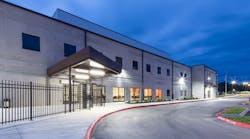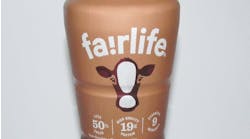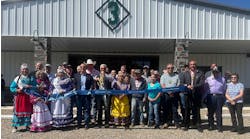What does it mean for a food plant’s design to be “modern”?
Manufacturing facilities of all kinds have always had one basic mission: to make things as efficiently, profitably and safely as possible. All aspects of their design point toward that goal. But as shifts occur in technology, consumer preferences and business priorities in general, the design of new food and beverage plants sometimes has to change to accommodate them.
In fact, the ability to accommodate change itself is one of the most important things to keep in mind when designing a new plant, says Ron Rens, executive vice president of Gleeson Constructors & Engineers LLC.
“When you talk modern design, I guess my first thought would be versatility,” Rens says. “To make sure that the customers can move into a facility with a line and have it versatile enough so that if their needs change, that they can quickly change that line within the facility.”
Make cleaning easy
Another basic consideration getting increased attention is cleanability. In both design and choice of materials, priority is being given to making sure that all areas of a plant can be easily cleaned, and avoiding problem areas where contamination can fester.
Accessibility is the key, says Sean Barr, senior director of project planning at The Austin Co. He cites the adage: If you can’t see it, you can’t clean it.
“What we try to do, both in facility design and in working with equipment suppliers, is make the easiest thing the right thing to do,” Barr says.
Enabling sanitation sometimes involves getting away from standard ways of doing things, It can be as simple as not putting pipes flush against walls, so that there aren’t long, hard-to-clean crevices along them, and not supporting pipes and conduits with Unistrut channel brackets, which are cheap and effective but are made with perforations and grooves where dust and other contamination can easily collect.
“Within the past, I guess, 10 years, the materials of commercial construction available in the marketplace have really expanded that respond to these requirements, in terms of getting away from Unistruts and pipe standoffs,” Cathcart says. “Food companies that were hiring a general contractor that did not understand food grade, they would put Unistruts all over the plant, and then when it comes to sanitation, you’ve got all these harborages for dust and microbes.”
Material choices have evolved to align with sanitation requirements. Barr says that concrete, long the go-to material for its durability and relatively low cost, has come to be seen as a sanitation concern.
“Everybody likes the durability of concrete on the walls in the manufacturing areas,” Barr says. “but the porous nature of concrete has always been a challenge. There can be some challenges in cleaning to a bacteriological standpoint.” Coatings that block the concrete’s pores and repel water help make them more cleanable.
An alternative for interior walls is insulated metal panels, which aren’t as durable as concrete but are easier to clean. The trend with them, Barr says, is to use stainless steel or special coatings like Kynar instead of baked-on enamel, especially in plants that will be subjected to washdowns with highly caustic chemicals.
Hygienic design, with enough room to scale up as needed, are mainstays of modern plant design. Photo: Food Plant Engineering
Sanitation is one aspect of food plant operations where it pays to take a “holistic” approach, says Mark Redmond, president of Food Plant Engineering LLC and Food Plant Construction LLC.
“I see many facilities where the focus is on specific elements of a hygienic design, without consideration for how those elements fit into the overall facility,” Redmond says. A holistic approach includes aspects like making sure how drains should be tied into flooring to eliminate cracks and crevices, and how ambient temperature should be controlled to achieve optimal humidity and avoid moisture buildup.
Energetic planning
Energy efficiency, one of the biggest concerns in plant operations, can be addressed in various ways, especially with new construction.
One of the most common ways to approach energy efficiency is to seek LEED (Leadership in Energy and Environmental Design) certification from the U.S. Green Building Council. However, some builders, and their customers, are questioning whether qualifying for a LEED certificate is truly adequate as an energy efficiency strategy.
“You throw money at them to get the certification,” says CRB’s McAllister. “Unless they have clients that they’re providing their products to that want it, they’re not seeing the same benefit as we used to see five to eight years ago.”
Instead, builders are seeking efficiency from a combination of basic techniques and material choices, and innovative technologies.
Meat processing and packaging plants, like this Kraft Heinz facility in Davenport, Iowa, need sanitation to be top of mind in design. Photo: Gray
“The energy codes are becoming more and more stringent as far as building the envelopes are concerned, and the thermal value of those envelopes,” says Troy Sandlin, Gray’s director of A&E services for food & beverage. “Sometimes we have a large delta-T [heat transfer] from the inside to the outside of the building, so close consideration of the building materials is needed. Usually we’re above and beyond the required energy code. So if it’s a four-inch insulated metal panel, you’re getting in the neighborhood of an R-34 when the energy code suggests an R-19.”
Among the most voracious users of electric power in a plant are heating and refrigeration systems, for both processing and HVAC. Some of the latest technology for energy saving involves harvesting heat from boilers or from condenser coils in mechanical refrigeration. This heat can be used to heat water for processing or plumbing or air entering the plant.
More generally, saving energy often means installing the most energy-efficient boilers and refrigeration systems, or upgrading them after the fact. However, that isn’t a blanket prescription, McAllister warns. Energy-efficiency features cost money, especially when they’re retrofitted, and a realistic ROI depends on local energy costs.
“It depends on where you are in the country,” she says. “When I’ve done projects up in the Northeast, and we’ll just use Boston for example, energy costs are very high. So your ROI on putting in a very efficient boiler and adding an economizer – you may be looking at a three-year payback. I just did a project in Wisconsin, and the cost of power is very low. The $15,000 to add an economizer to the boiler was like a 20-year payback.”
Good look, good feel
Aesthetics in food and beverage plant design have traditionally been neglected, if not completely ignored. The function of a plant, after all, is to make things, not to look good.
But forward-thinking companies are increasingly recognizing the value of pleasing, even beautiful, design in creating an agreeable work environment.
“Customers today really do have a high interest in exploring the methods where you can offer the best and most pleasing workspace to their employees,” says Tyler Cundiff, VP of business development for food & beverage at Gray.
Improved aesthetics begin on the outside, where drab, monolithic exteriors are giving way to increased window space, precast architectural panels, landscaping and other touches. Sometimes exterior improvements don’t even have to cost much, says Austin Co.’s Barr.
“We try to look for low-cost aesthetic improvement,” he says. “We did a plant recently where there were prestressed concrete walls on the exterior, which were kind of not appealing, I guess, to everyone. What we ended up doing was just sandblasting, prior to delivery, a couple of stripes on the exterior of the building, just to give it some variation and a little bit of a pop. Doing that didn’t cost very much at all.”
One way that aesthetics can improve the worker experience is in welfare areas, the parts of the plant where employees congregate when they’re not working, like cafeterias and breakrooms. A good design with lots of natural light (which is usually not an option in processing areas) and as good a view as possible, perhaps with amenities like wi-fi, will be a long-term boost for morale.
“I think how people are treated and what amenities they’re provided in the production environment will contribute or promote longevity in workforce retention, versus the minute they get a ten-cent [increase] offer from the plant that’s across the street, they jump ship and go over there,” Cathcart says.
In many cases, it’s important to pay attention to the experience of visitors as well as workers. Many plants find it worthwhile to conduct regular tours, as a source of publicity and a way to connect with trade customers, the community and the general public. The best way is to do that with corridors, sometimes enclosed and/or elevated, that give a thorough view of the plant while maintaining safety and sanitation standards.
“Safely bringing customers into a plant and having them exiting without gowning up, that’s one of the things we see all the time,” Cathcart says.
A food or beverage plant is more than a box pumping out widgets. Applying modern, or at least updated, principles of plant design can make it run as efficient and harmoniously as possible, now and in the future.


